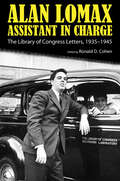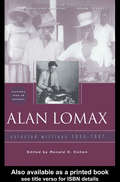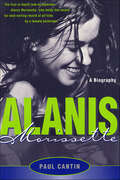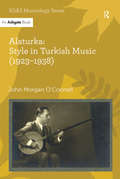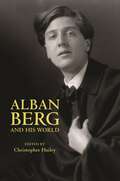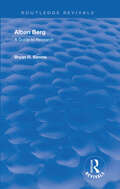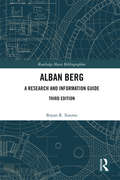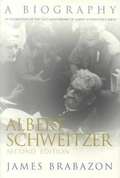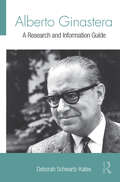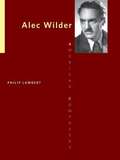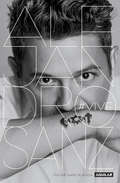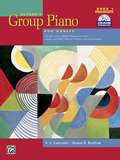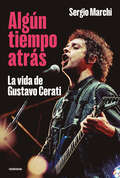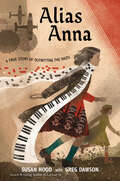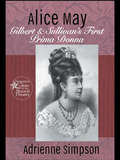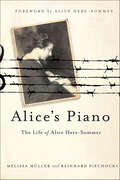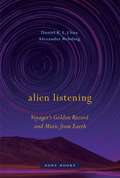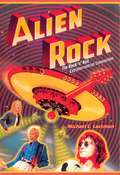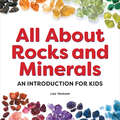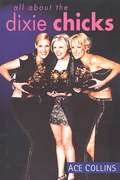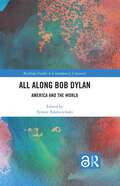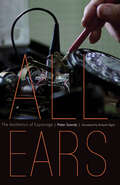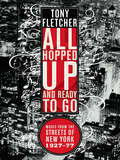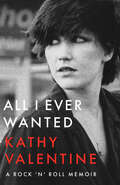- Table View
- List View
Alan Lomax, Assistant in Charge: The Library of Congress Letters, 1935-1945 (American Made Music Series)
by Ronald D. CohenAlan Lomax (1915-2002) began working for the Archive of American Folk Song at the Library of Congress in 1936, first as a special and temporary assistant, then as the permanent Assistant in Charge, starting in June 1937, until he left in late 1942. He recorded such important musicians as Woody Guthrie, Muddy Waters, Aunt Molly Jackson, and Jelly Roll Morton. A reading and examination of his letters from 1935 to 1945 reveal someone who led an extremely complex, fascinating, and creative life, mostly as a public employee.While Lomax is noted for his field recordings, these collected letters, many signed "Alan Lomax, Assistant in Charge," are a trove of information until now available only at the Library of Congress. They make it clear that Lomax was very interested in the commercial hillbilly, race, and even popular recordings of the 1920s and after. These letters serve as a way of understanding Lomax's public and private life during some of his most productive and significant years. Lomax was one of the most stimulating and influential cultural workers of the twentieth century. Here he speaks for himself through his voluminous correspondence.
Alan Lomax: Selected Writings, 1934-1997 (American Made Music Ser.)
by Ronald D. CohenAlan Lomax is a legendary figure in American folk music circles. Although he published many books, hundreds of recordings and dozens of films, his contributions to popular and academic journals have never been collected. This collection of writings, introduced by Lomax's daughter Anna, reintroduces these essential writings. Drawing on the Lomax Archives in New York, this book brings together articles from the 30s onwards. It is divided into four sections, each capturing a distinct period in the development of Lomax's life and career: the original years as a collector and promoter; the period from 1950-58 when Lomax was recording thorughout Europe; the folk music revival years; and finally his work in academia.
Alanis Morissette: A Biography
by Paul CantinJust two years ago Alanis Morissette was a former teen pop star, dismissed by some as a footnote in Canadian pop history. Then her album Jagged Little Pill sold over 13 million copies worldwide, and a new queen of alternative rock was crowned.Here Paul Cantin tells the tale of how Morissette transformed herself from failed teenage star into an artist whose work speaks to an entire generation. With multiple Grammys and MTV Awards under her belt; this singer/songwriter has achieved what none thought possible. This is the story of that rare second chance.Included in this book are: Morissette's own account of her songwriting inspiration, exclusive interview material, a front-row account of the 1996 Grammy Awards, and never before-seen photos. This is the one book no Morrisette fan will want to be without.
Alaturka: Style in Turkish Music (SOAS Studies in Music Series)
by John Morgan O'ConnellThe early-Republican era (1923-1938) was a major period of musical and cultural change in Turkey. Alaturka: Style in Turkish Music is a study of the significance of style in Turkish music and, in particular, the polemical debate about an eastern style of Turkish music (called, alaturka) that developed during this rich and complicated era of Turkish history. Representing more than twenty years of research, the book explores the stylistic categories that show the intersection between music and culture; the different chapters treat musical materials, musical practices and musical contexts in turn. Informed by critical approaches to musical aesthetics in ethnomusicology as well as musicology and anthropology, the book focuses upon a native discourse about musical style, highlighting a contemporary apprehension about the appropriate constitution of a national identity. The argument over style discloses competing conceptions of Turkish space and time where definitions of the east and the west, and interpretations of the past and the present respectively were hotly contested. John Morgan O'Connell makes a significant contribution to the study of Turkish music in particular and Turkish history in general. Conceived as a historical ethnography, the book brings together archival sources and ethnographic materials to provide a critical revision of Turkish historiography, music providing a locus for interrogating singular representations of a national past.
Alban Berg and His World (The Bard Music Festival #24)
by Christopher HaileyAn incisive new look at the pivotal modernist composerAlban Berg and His World is a collection of essays and source material that repositions Berg as the pivotal figure of Viennese musical modernism. His allegiance to the austere rigor of Arnold Schoenberg's musical revolution was balanced by a lifelong devotion to the warm sensuousness of Viennese musical tradition and a love of lyric utterance, the emotional intensity of opera, and the expressive nuance of late-Romantic tonal practice.The essays in this collection explore the specific qualities of Berg's brand of musical modernism, and present newly translated letters and documents that illuminate his relationship to the politics and culture of his era. Of particular significance are the first translations of Berg's newly discovered stage work Night (Nocturne), Hermann Watznauer's intimate account of Berg's early years, and the famous memorial issue of the music periodical 23. Contributors consider Berg's fascination with palindromes and mirror images and their relationship to notions of time and identity; the Viennese roots of his distinctive orchestral style; his links to such Viennese contemporaries as Alexander Zemlinsky, Franz Schreker, and Erich Wolfgang Korngold; and his attempts to maneuver through the perilous shoals of gender, race, and fascist politics.The contributors are Antony Beaumont, Leon Botstein, Regina Busch, Nicholas Chadwick, Mark DeVoto, Douglas Jarman, Sherry Lee, and Margaret Notley.
Alban Berg: A Research and Information Guide
by Bryan R. SimmsAlban Berg: A Research and Information Guide is an annotated bibliography concerning both the nature of primary sources related to the composer and the scope and significance of the secondary sources which deal with him, his compositions, and his influence as a composer. The second edition will include research published since the publication of the first edition and provide electronic resources.
Alban Berg: A Research and Information Guide (Routledge Music Bibliographies #Vol. 38)
by Bryan R. SimmsAlban Berg: A Research and Information Guide, Third Edition is an annotated bibliography highlighting both the nature of primary sources related to the composer and the scope and significance of the secondary sources that deal with Berg, his compositions, and his influence as a composer. It is a reliable, complete, and useful resource and a starting point for anyone—performer, teacher, student, or scholar—wanting to learn about Berg’s life, works, and cultural milieu. The third edition has 162 additional citations since the publication of the second edition, many arising after the expiration of copyright of Berg’s musical and archival works 2005. Many important new, primary sources of information have appeared, most notably the letter exchanges with his wife, recently published in a three-volume critical edition (in German), as well as letter exchanges with Alma Mahler and Erich Kleiber, and later correspondences with Anton Webern. There has also been a notable increase in the availability of commercial video recordings of Berg's operas, Wozzeck and Lulu.
Albert Schweitzer: A Biography
by James BrabazonJames Brabazon updates his critically acclaimed biography of humanitarian Albert Schweitzer to include a wealth of recently discovered documents, including the letters between Schweitzer and Helene Bresslau written during the ten years before their marriage. Brabazon's research has also included recently released documents from the State Department regarding Schweitzer's battle with the United States Atomic Energy Commission to halt H-bomb tests.
Alberto Ginastera: A Research and Information Guide (Routledge Music Bibliographies)
by Deborah Schwartz-KatesAlberto Ginastera: A Research and Information Guide is the first bio-bibliographic study of the composer and the only published book on the subject in English. This work fills a critical gap in contemporary music studies by enriching our knowledge of one of the most compelling creative voices of the Americas. Given the lack of prior systematic attention to Ginastera, this book establishes a firm foundation for future scholarship. It includes a detailed biographical sketch of the composer that quotes extensively from his letters. It summarizes the defining features of his style and encompasses his infrequently explored late works. It offers the most comprehensive catalogue of Ginastera’s music to date and provides an annotated list of his published writings. This book contains over 400 annotated bibliographic entries that refer to critically selected sources in English, Spanish, French, German, and Italian. The last chapter offers new information about archival holdings and internet resources that facilitates research on this composer. An appendix featuring a detailed chronology of Ginastera’s career completes this work.
Alec Wilder
by Philip LambertThe music of Alec Wilder (1907-1980) blends several American musical traditions, such as jazz and the American popular song, with classical European forms and techniques. Stylish and accessible, Wilder's musical oeuvre ranged from sonatas, suites, concertos, operas, ballets, and art songs to woodwind quintets, brass quintets, jazz suites, and hundreds of popular songs. In this biography and critical investigation of Wilder's music, Philip Lambert chronicles Wilder's early work as a part-time student at the Eastman School of Music, his ascent through the ranks of the commercial recording industry in New York City in the 1930s and 1940s, his turn toward concert music from the 1950s onward, and his devotion late in his life to the study of American popular songs of the first half of the twentieth century. The book discusses some of his best-known music, such as the revolutionary octets and songs such as "I'll Be Around," "While We're Young," and "Blackberry Winter," and explains the unique blend of cultivated and vernacular traditions in his singular musical language.
Alejandro Sanz. #VIVE
by Óscar García BlesaLa biografía autorizada de Alejandro Sanz, el artista español más influyente de las últimas tres décadas. Alejandro Sanz. #VIVE es un relato colectivo en forma de historia oral del que puede considerarse el artista español más influyente de las últimas tres décadas. Escrita por el experto musical Óscar García Blesa, ejecutivo discográfico que vivió en primera persona el nacimiento del disco MÁS y que comparte una estrecha relación con Alejandro Sanz desde hace más de veinte años, el libro se construye con testimonios de más de doscientas personalidades relevantes en la vida del artista, tanto de su ámbito personal como del mundo de la cultura, política y actualidad nacional e internacional (Joan Manuel Serrat, Penélope Cruz, Rafael Nadal, Jorge Ramos o Alicia Keys, entre otros), incluida la voz del propio Alejandro. Alejandro Sanz. #VIVE conforma el retrato más personal del artista, en una edición sumamente cuidada y con un formato especial. Todo ello apoyado con una selección de fotografías de su archivo personal. #VIVE supone un trabajo que profundiza en la génesis de su álbum MÁS (el disco más vendido de la historia de la música española) y que traza un perfil biográfico a través de las voces de personajes cercanos al artista madrileño. Un puzle con centenares de piezas que desembocan en la banda sonora de Alejandro Sanz. En palabras del propio Alejandro: «Hay canciones que al cerrar los ojos se convierten en personas». A lo largo de sus más de quinientas páginas, familiares y amigos, artistas, políticos, deportistas y otros personajes principales en la vida del cantante junto a las propias reflexiones de Alejandro, sumergen al lector en un viaje que recorrerá sus propias emociones y vivencias dibujando el mapa íntimo y sonoro de varias generaciones.
Alfred's Group Piano For Adults Student Book: An Innovative Method (Alfred's Group Piano For Adults #Book 1)
by E. L. Lancaster Kenon D. RenfrowThe Second Edition of Alfred's Group Piano for Adults Book 1, includes updates inspired by numerous recommendations from group piano teachers and students. This book includes a CD-ROM containing both Audio and General MIDI Files of the 500+ accompaniments included in the text, each with an interesting and engaging arrangement coupled with the piano part. Designed for collegiate non-keyboard music majors with little or no keyboard experience, the easy-to-use text contains 26 units, each intended to be covered in one week, thus fulfilling two semesters or three quarters of study. Theory, technique, sight-reading, repertoire, harmonization, improvisation, and ensemble activities are taught thoroughly and consistently throughout the text.
Algún tiempo atrás. La vida de Gustavo Cerati
by Sergio MarchiLa biografía definitiva de Gustavo Cerati, uno de los músicos argentinos de mayor trascendencia internacional, escrita por uno de los periodistas e historiadores que mejor lo conoció, y que pone en un mismo, exhaustivo tomo, hecho de infinidad de entrevistas y un enorme archivo personal, las distintas dimensiones del hombre y el artista, su recorrido vital, su fuerza creativa y su enorme legado. La perfección es inalcanzable. Sin embargo, Gustavo Cerati la buscó con fuerza y pasión en su arte. En conexión con ese espíritu irreductible, Algún tiempo atrás. La vida de Gustavo Cerati aborda el recorrido vital y creativo del hombre y del artista con la misma conciencia -la de que hay enigmas de imposible resolución- pero sin limitarse jamás en su afanosa investigación. Decidido a recuperar la parte más luminosa de esta figura única, la de uno de los músicos argentinos de mayor proyección internacional, Sergio Marchi no deja rincón sin visitar: en procura tanto del compositor e intérprete que trascendió masivamente con Soda Stereo y luego se reinventó en una extraordinaria carrera solista, como del hijo de una familia trabajadora que -dato que suele olvidarse bajo el prejuicioso mito del "cheto"- llegó desde el interior del país a la Buenos Aires de los 50; del niño travieso, curioso y activo; del adolescente insaciable que conoció la ebullición rockera de los 70; de ese muchacho que supo que habría de hacerse a sí mismo a fuerza de talento y también de trabajo. Del ser enamoradizo que encontró en las mujeres un manantial inagotable de inspiración, mucho amor y no pocos padecimientos; del marido y padre que anheló ser. Del obrero musical que muy poca gente conoció; que experimentó con el rock, el pop, la electrónica, con la tecnología y con sus pelos. Y de la estrella hábil, escurridiza y audaz que lidió con adversidades externas e internas y supo sortear muchas de las trampas de la fama. Del hombre que transitó varias lunas y unas cuantas vidas. En virtud de una investigación minuciosa, una multitud de entrevistas exclusivas a otros artistas, amigos y allegados, y un archivo personal enorme forjado a través de una relación de años que fue un vínculo profesional pero también de afecto y complicidad, Marchi pone en juego las múltiples dimensiones de este hacedor de universos, desbarata algunas falsas creencias y recupera la magia de un personaje a la vez mítico y absolutamente real y sensible, de carne y hueso.
Alias Anna: A True Story of Outwitting the Nazis
by Greg Dawson Susan HoodThe moving true story of how young Ukrainian Jewish piano prodigies Zhanna (alias “Anna”) and her sister Frina outplayed their pursuers while hiding in plain sight during the Holocaust. A middle grade nonfiction novel-in-verse by award-winning author Susan Hood with Greg Dawson (Zhanna’s son).She wouldn’t be Zhanna. She’d use an alias. A for Anna. A for alive.When the Germans invade Ukraine, Zhanna, a young Jewish girl, must leave behind her friends, her freedom, and her promising musical future at the world’s top conservatory. With no time to say goodbye, Zhanna, her sister Frina, and their entire family are removed from their home by the Nazis and forced on a long, cold, death march. When a guard turns a blind eye, Zhanna flees with nothing more than her musical talent, her beloved sheet music, and her father’s final plea: “I don’t care what you do. Just live.” This incredible true story in-verse about sisterhood, survival, and music is perfect for fans of Lifeboat 12, Inside Out and Back Again, and Alan Gratz.Includes extensive back matter with original letters and photographs, additional information, and materials for further reading.
Alice May: Gilbert & Sullivan's First Prima Donna (Forgotten Stars of the Musical Theatre)
by Adrienne SimpsonThis biography tells the story of Alice May, a touring prima donna in the nineteenth century who travelled from England to Australia, New Zealand, India and the US, taking part in pioneering performances of the popular light operas of the day. Along the way she took part in many premieres, including the first production of Gilbert and Sullivan's The Sorcerer and the first authorised American production of The Mikado . This colourful life story will appeal to theatre historians, fans of the melodrama, burlesque, and the musical stage.
Alice's Piano: The Life of Alice Herz-Sommer
by Melissa Müller Reinhard PiechockiThe story of Holocaust survivor and pianist Alice Herz-Sommer: “A miraculous journey of mother and son for whom music provided strength and nourishment.” —Kirkus ReviewsAlice Herz-Sommer was born in Prague in 1903. A talented pianist from a very early age, she became famous throughout Europe. But as the Nazis rose to power, her world crumbled. In 1942, her mother was deported to the Theresienstadt concentration camp and vanished. In 1943, Alice, her husband, and their six-year-old son were sent there, too.In the midst of horror, music, especially Chopin’s Etudes, was Alice’s salvation. Theresienstadt was a “show camp” —a living slice of Nazi propaganda created to convince outsiders that the Jews were being treated humanely. In more than a hundred concerts, Alice gave her fellow prisoners hope in a time of suffering. Written with the cooperation of Alice Herz-Sommer, who contributes a foreword, Melissa Müller and Reinhard Piechocki’s Alice’s Piano is the first time her story has been told.“Most moving is the story throughout of her loving bond with her son and how she saved him. No politics, intolerance, or self-righteousness, no talk of revenge, always the rigor and joy of music.” —Booklist (starred review)Published in the UK as A Garden of Eden in Hell
Alien Listening: Voyager's Golden Record and Music from Earth
by Daniel K. Chua Alexander RehdingAn examination of NASA's Golden Record that offers new perspectives and theories on how music can be analyzed, listened to, and thought about—by aliens and humans alike.In 1977 NASA shot a mixtape into outer space. The Golden Record aboard the Voyager spacecrafts contained world music and sounds of Earth to represent humanity to any extraterrestrial civilizations. To date, the Golden Record is the only human-made object to have left the solar system. Alien Listening asks the big questions that the Golden Record raises: Can music live up to its reputation as the universal language in communications with the unknown? How do we fit all of human culture into a time capsule that will barrel through space for tens of thousands of years? And last but not least: Do aliens have ears?The stakes could hardly be greater. Around the extreme scenario of the Golden Record, Chua and Rehding develop a thought-provoking, philosophically heterodox, and often humorous Intergalactic Music Theory of Everything, a string theory of communication, an object-oriented ontology of sound, and a Penelopean model woven together from strands of music and media theory. The significance of this exomusicology, like that of the Golden Record, ultimately takes us back to Earth and its denizens. By confronting the vast temporal and spatial distances the Golden Record traverses, the authors take listeners out of their comfort zone and offer new perspectives in which music can be analyzed, listened to, and thought about—by aliens and humans alike.
Alien Rock: The Rock 'n' Roll Extraterrestrial Connection
by Michael LuckmanWhether you&’re a UFO skeptic, believer, or merely a rock music fan, Alien Rock takes you on a fascinating and irreverent journey exploring the extraterrestrial stories of your favorite rock icons. From Elvis to the Beatles and from Michael Jackson to Marilyn Manson, countless rock stars have claimed to have seen, communed with, been inspired by, and sometimes even descended from extraterrestrials. Now you can discover these stories for yourself in this illuminating, all-access pass to rock&’s unearthly encounters—some friendly, some frightening, and some frankly bizarre. From John Lennon spying a UFO from his penthouse in 1974 to Jimi Hendrix&’s claim that he was a messenger from &“another place,&” there is no extraterrestrial tale neglected. With witty prose and in-depth research, Alien Rock provides a fascinating new perspective on the long, strange trip that is rock history, and suggests that, wherever the road takes us, we may not be traveling alone.
All About Rocks and Minerals: An Introduction for Kids
by Lisa TrusianiDig in to a fun first look at rocks and gems for kids ages 3 and up From tiny pebbles to huge mountains, rocks are everywhere! And young rockhounds can explore them with All About Rocks and Minerals. It's packed full of fascinating facts and photos that introduce kids to 50 impressive stones. They'll discover what each one looks like, what makes it unique, and more.The life of a rock—Start with a brief introduction that explains how rocks are formed, the 3 types of rock, and the difference between rocks, minerals, and crystals.Big, beautiful images—Colorful pictures let kids get up close and personal with all kinds of awesome rocks and gems.Amazing rock facts—Did you know that there's a special stone for the month you were born? Or that sailors believed aquamarine would protect them at sea?Give curious kids an exciting introduction to geology with this rocks and minerals book for kids.
All About the Dixie Chicks
by Ace CollinsJust two short years ago, The Dixie Chicks were practically unheard-of outside of Texas, but today, they're the hottest act in country music. The explosive popularity of their album Wide Open Spaces has rocketed the Chicks to the top of the charts, and in the last year alone, they have won three Grammys (Best Country Album, Best New Artist and Best Country performance by a duo or group with vocal), two Country Music Association awards and an American Music Award. Their new album is expected to do even better. Now, veteran country music writer Ace Collins has captured their whole inspiring story, from their early days playing to loyal fans in Dallas, right up to their current success and thrilling future!
All Along Bob Dylan: America and the World (Routledge Studies in Contemporary Literature)
by J. Roger KurtzAll Along Bob Dylan: America and the World offers an important contribution to thinking about the artist and his work. Adding European and non-English speaking contexts to the vibrant field of Dylan studies, the volume covers a wide range of topics and methodologies while dealing with the inherently complex and varied material produced or associated with the iconic artist. The chapters, organized around three broad thematic sections (Geographies, Receptions and Perspectives), address the notions of audience, performance and identity, allowing to map out the structure of feeling and authenticity, both, in the case of the artist and his audience. Taking its cue from the collapse of the so-called high-/ low culture split following from the Nobel Prize, the book explores the argument that Dylan (and all popular music) can be interpreted as literature and offers discussions in the context of literary traditions, or visual culture and music. This contributes to a nuanced and complex portrayal of the seminal cultural phenomenon called Bob Dylan.
All Ears: The Aesthetics of Espionage
by Peter SzendyThe world of international politics has recently been rocked by a seemingly endless series of scandals involving auditory surveillance: the NSA’s warrantless wiretapping is merely the most sensational example of what appears to be a universal practice today. What is the source of this generalized principle of eavesdropping?All Ears: The Aesthetics of Espionage traces the long history of moles from the Bible, through Jeremy Bentham’s “panacoustic” project, all the way to the intelligence-gathering network called “Echelon.” Together with this archeology of auditory surveillance, Szendy offers an engaging account of spycraft’s representations in literature (Sophocles, Shakespeare, Joyce, Kafka, Borges), opera (Monteverdi, Mozart, Berg), and film (Lang, Hitchcock, Coppola, De Palma). Following in the footsteps of Orpheus, the book proposes a new concept of “overhearing” that connects the act of spying to an excessive intensification of listening. At the heart of listening Szendy locates the ear of the Other that manifests itself as the originary division of a “split-hearing” that turns the drive for mastery and surveillance into the death drive.
All Hopped Up and Ready to Go: Music from the Streets of New York 1927-77
by Tony FletcherA penetrating and entertaining exploration of New York's music scene from Cubop through folk, punk, and hip-hop. From Tony Fletcher, the acclaimed biographer of Keith Moon, comes an incisive history of New York's seminal music scenes and their vast contributions to our culture. Fletcher paints a vibrant picture of mid-twentieth-century New York and the ways in which its indigenous art, theater, literature, and political movements converged to create such unique music. With great attention to the colorful characters behind the sounds, from trumpet player Dizzy Gillespie to Tito Puente, Bob Dylan, and the Ramones, he takes us through bebop, the Latin music scene, the folk revival, glitter music, disco, punk, and hip-hop as they emerged from the neighborhood streets of Harlem, the East and West Village, Brooklyn, the Bronx, and Queens. All the while, Fletcher goes well beyond the history of the music to explain just what it was about these distinctive New York sounds that took the entire nation by storm.
All I Ever Wanted: A Rock 'n' Roll Memoir
by Kathy Valentine&“Recounts in vivid detail the gloriously debauched path of the Go-Gos through early rock success . . . and the darkness that such freedom can breed.&” —Los Angeles Times Runner-up, Carr P. Collins Award for Best Book of Non-Fiction At twenty-one, Kathy Valentine was at the Whisky in Los Angeles when she met a guitarist from a fledgling band called the Go-Go&’s and the band needed a bassist. The Go-Go&’s became the first multi-platinum-selling, all-female band to play instruments themselves, write their own songs, and have a number one album. Their debut, Beauty and the Beat, spent six weeks at the top of the Billboard 200 and featured the hit songs &“We Got the Beat&” and &“Our Lips Are Sealed.&” The record&’s success brought the pressures of a relentless workload and schedule culminating in a wild, hazy, substance-fueled tour that took the band from the club circuit to arenas, where fans, promoters, and crew were more than ready to keep the party going. All I Ever Wanted traces the path that took Valentine from her childhood in Texas—where she all but raised herself—to the height of rock n&’ roll stardom, devastation after the collapse of the band that had come to define her, and the quest to regain her sense of self after its end. Valentine also speaks candidly about the lasting effects of parental betrayal, abortion, rape, and her struggles with drugs and alcohol—and the music that saved her every step of the way. &“An epic tour of honest storytelling. All I Ever Wanted is a raw look at the highs and lows of being high and low. Long live the Go-Gos!&” —Amy Poehler
All I Ever Wanted: A Rock 'n' Roll Memoir
by Kathy Valentine&“Recounts in vivid detail the gloriously debauched path of the Go-Gos through early rock success . . . and the darkness that such freedom can breed.&” —Los Angeles Times Runner-up, Carr P. Collins Award for Best Book of Non-Fiction At twenty-one, Kathy Valentine was at the Whisky in Los Angeles when she met a guitarist from a fledgling band called the Go-Go&’s and the band needed a bassist. The Go-Go&’s became the first multi-platinum-selling, all-female band to play instruments themselves, write their own songs, and have a number one album. Their debut, Beauty and the Beat, spent six weeks at the top of the Billboard 200 and featured the hit songs &“We Got the Beat&” and &“Our Lips Are Sealed.&” The record&’s success brought the pressures of a relentless workload and schedule culminating in a wild, hazy, substance-fueled tour that took the band from the club circuit to arenas, where fans, promoters, and crew were more than ready to keep the party going. All I Ever Wanted traces the path that took Valentine from her childhood in Texas—where she all but raised herself—to the height of rock n&’ roll stardom, devastation after the collapse of the band that had come to define her, and the quest to regain her sense of self after its end. Valentine also speaks candidly about the lasting effects of parental betrayal, abortion, rape, and her struggles with drugs and alcohol—and the music that saved her every step of the way. &“An epic tour of honest storytelling. All I Ever Wanted is a raw look at the highs and lows of being high and low. Long live the Go-Gos!&” —Amy Poehler
